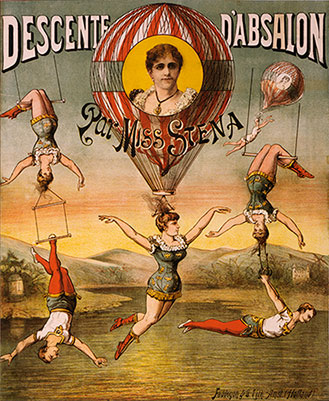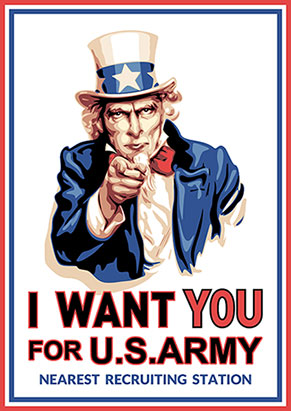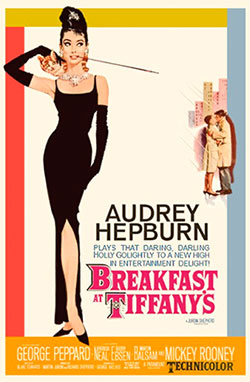01. History of Posters
In spite of what its definition says, the poster is not only a printed piece of paper attached to any vertical surface. In some way, it is an art. And being an art, it is a way for society to have a look at itself. At the same time, the poster offers a way of communicating to the masses. First public posters appeared in the 15th century and changed the way of making public announcements and proclamations from kings. Town criers were no longer needed to announce edicts from the King, the Church or the Brotherhood.
In the days of William Shakespeare posters were around, too. Put up all about the town, they invited people to Shakespeare's latest play. Since then, both eye-catching and informative posters grabbed attention of passers-by in public places around the world. The main purpose of first posters was to advertise products. Later they were also used to inform people about political viewpoints or to notify them of various events.
Royal Navy recruitment poster from the Napoleonic wars, 1800

(Click to enlarge)
The birth of the lithographic poster
A typical poster art combines graphics with some kind of text. It can be only graphics or only text, as well. To fulfill its tasks, a poster should be visually striking, eye-catching and clear for people. An obscure poster is nonsense: if people do not understand the designer's idea, it means that he failed.
Jean-Michel Papillon from France is considered to be the first poster designer and the inventor of the wallpaper. Back in 1675, he engraved rustic designs into woodworks in continuous, matching patterns. But due to a painstaking process of poster production, posters appeared very slowly. Artisans had to engrave a poster into a woodwork or metal sheets manually, with little or no design and colour.
Everything changed with the birth of the lithographic printing in 1796. Lithography was invented by Alois Senefelder in Austria when he was searching for an alternative to expensive metal plate engraving. He offered a series of lithos, metal or stone carvings, tinted with ink to make a print. The printed image was reversed, so images and words were to be drawn backwards. In lithography letters could be hand drawn opening the way to type designs. Moreover, the mechanized process made it possible to produce numerous posters in all sizes and shapes.
Soon the mass media embraced posters for promotional purposes in France and throughout Europe. Printed advertisements appeared in newspapers, theatre and opera shows in Paris started using "poster advertisements" to announce important events. Publishers and writers appreciated the newly appeared poster art. In 19th century, great lithographic designers like Raffet, Gavarni and Johannot illustrated the most acclaimed masterpieces of French literary works.
Lithography was a huge step forward, but at first it was too slow and expensive for printing poster. A French artisan Jules Cheret, known as the Father of the Poster, changed the situation. He made huge contributions to printing and design techniques and made posters a remarkable innovation of the period. He introduced a breakthrough three stone lithographic process, which improved existing printing poster techniques. Every rainbow colour could be reproduced by only three stones red, yellow and blue. Now it was possible to combine colour and texture with images and text. Although the process was difficult, the result was magnificent, hard to achieve even to this day. Finally, the lithographic poster became a powerful innovation and a dominant mass media in Europe and America. Big cities were transformed into "street art galleries" and ushered into the modern age of advertising.
Beautiful Era in France
For France 1880-1914 was both the period of economic growth and peace and frivolity known as the Belle Époque (Beautiful Era). The lithographic poster became an important visual element of this period. This was a golden era of illustration and graphic design. A poster craze came into its full bloom. Advertising goods and performances, the poster became a work of art for the middle class. Toulouse-Lautrec Moulin Rouge made the poster a fine art.
Circus poster between 1880 and 1900

(Click to enlarge)
During the Belle Époque national styles became more apparent. Dutch posters were marked by restraint and orderliness. Italian posters differed in their large size. German posters were known for their directness and mediaevalism.
Throughout the years, the look of the poster has been changing, but the essence is still the same. As stated above, most posters, particularly the early ones, were used for advertising products. Nowadays they offer us goods, events, films, music, books.
Motivational and propaganda posters through the World Wars
Posters were also widely used for propaganda purposes, motivation, and persuasion, especially, during wartime. During both the First (the Great War) and the Second World Wars recruiting posters became very common, like the British "Lord Kitchener Wants You”, American "Uncle Sam Wants You” and German "The Winter Aid” adding to national consciousness of war participants. During this time poster arts were also used to warn of foreign spies.
Uncle Sam Wants You poster

(Click to enlarge)
The global film and movie industry used the power of vibrantly coloured posters to draw people to cinemas. Today, most films are accompanied by posters, and collecting movie posters is a kind of hobby. Posters with pictures of famous rock bands and artists are frequent guests in teenagers' bedrooms, presenting their favourites.
Starting from the 1920's and 1930's posters have been used to promote holiday destinations both locally and around the globe. Among well-known travel posters were Art Deco style posters advertising American beach resorts.
The sixties and movie poster production
During the 20th century poster arts were often used for motivational purposes. They were incredibly popular during revolutions. The poster was a popular form of art in Cuba during and after the Cuban Revolution. During and after the Cuban Revolution the government of Cuba sponsored thousands of public posters covering social, cultural and political themes. In the 1960's and up to the 1980's, the posters impelled people of Cuba to build a new society. A famous photo of Alberto Korda turned the charismatic and controversial Che Guevara into a cultural icon. Its versions were painted, printed, embroidered, tattooed, silk-screened, sculpted and sketched on nearly every surface imaginable. The Maryland Institute College of Art The called the picture a symbol of the 20th century and the world's most famous photo. In 1967, Jim Fitzpatrickwho, an Irish artist, created Che Guevara posters using Korda's image. Even now we can see them in teenagers' bedrooms. A great proof that posters like this have enduring impacts.
Breakfast at Tiffany's movie poster, 1961

(Click to enlarge)
The rise of television in the 1950's influenced the movie poster production. Widely used for advertising and announcing upcoming films, they became a new form of movie art. Movie poster designers like Bob Peak and Robert McGinnis proved the poster to be a fine art. Innovative approach of Bob Peak to movie poster design (West Side Story, My Fair Lady, Camelot, Superman, Star Trek, etc.) brought him world-wide acknowledgement. In fact, he is known as the Father of modern movie poster design. Robert McGinnis is known for his movie posters created in the 1960's and 1970's for the James Bond series (Thunderball, You Only Live Twice, Diamonds are Forever, Live and Let Die, The Man with the Golden Gun).
